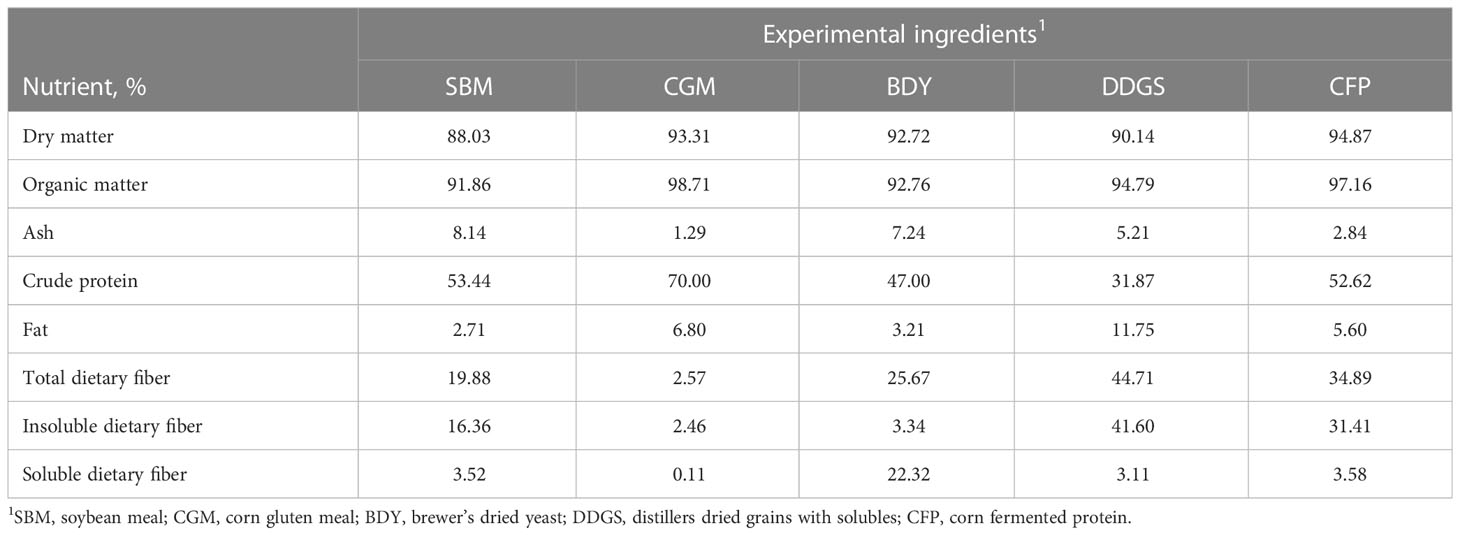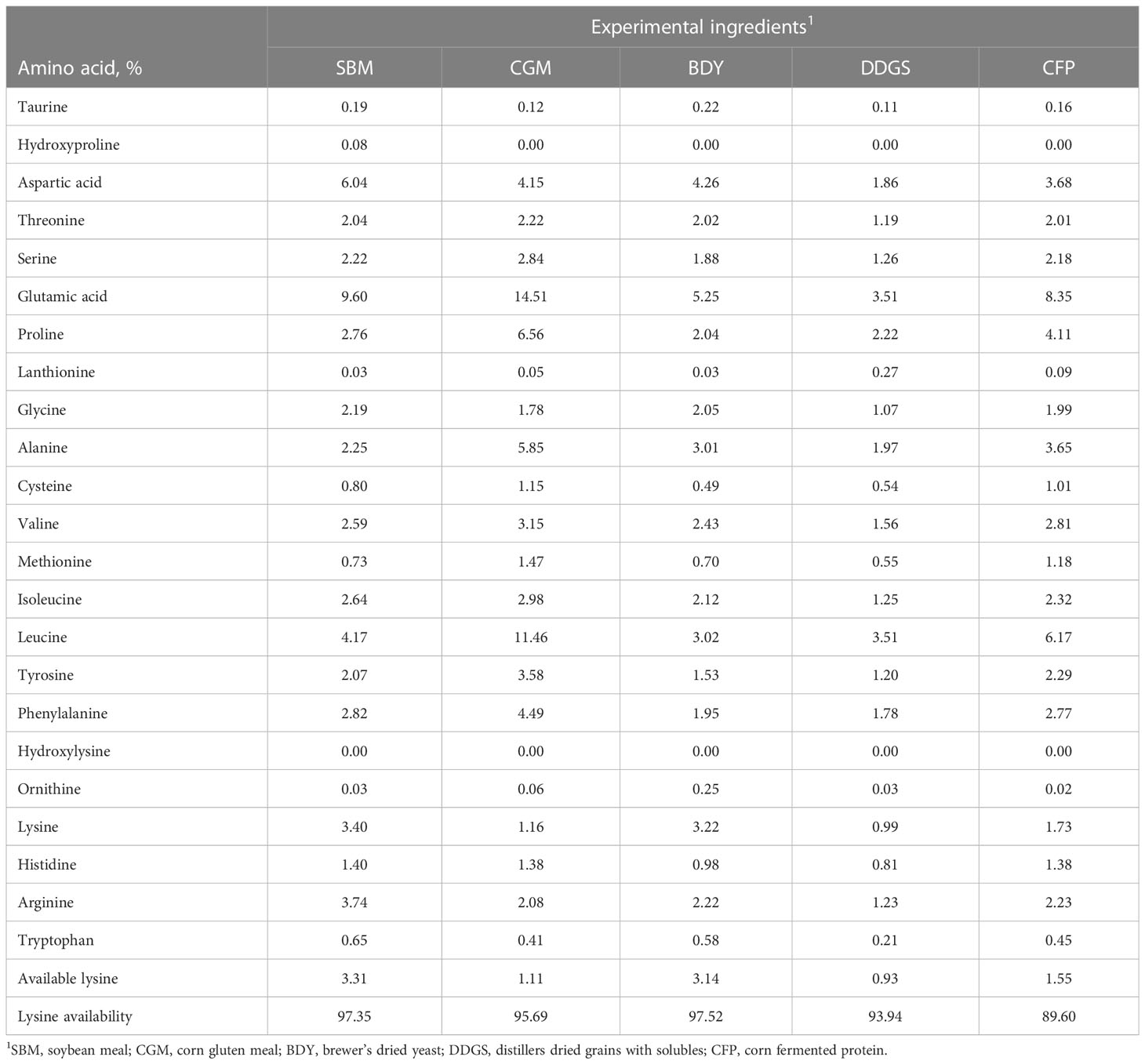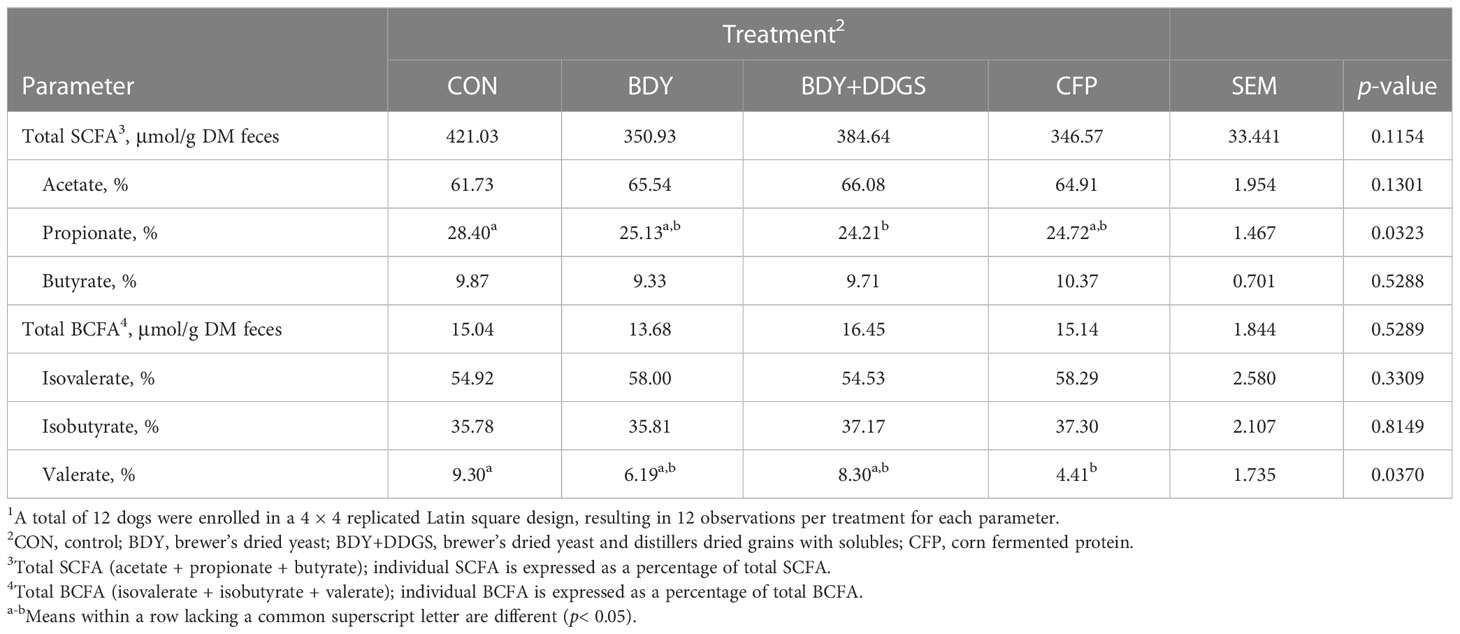- Department of Grain Science, Kansas State University, Manhattan, KS, United States
Traditional distillers dried grains, co-products from the ethanol industry, can be utilized as sustainable ingredients for pet food. However, negative consumer perception prevents their widespread use. Corn fermented protein (CFP) is produced using post-fermentation separation technology, resulting in a high protein ingredient, which may increase consumer appeal compared to traditional distillers dried grains. The study objective was to compare the effect of CFP with that of traditional distillers dried grains on stool quality, nutrient digestibility, and palatability when fed to dogs. The control diet (CON) contained 15% soybean meal and the experimental diets contained 3.5% brewer’s dried yeast (BDY), 2.5% brewer’s dried yeast plus 17.5% distillers dried grains with solubles (BDY+DDGS), or 17.5% corn fermented protein (CFP). Experimental diets were fed to adult dogs (n = 12) in a 4 × 4 replicated Latin square design. Dogs were adapted to the diets for 9 days; this was followed by 5 days of total fecal collection. Titanium dioxide (0.4%) was added to all diets as an external marker to estimate digestibility. Data were analyzed using a mixed model in SAS, with treatment as a fixed effect and dog and period as random effects. Fecal output was greatest (p< 0.05) for dogs fed BDY+DDGS. The feces of dogs consuming CFP were firmer (p< 0.05) than those of dogs consuming CON and BDY+DDGS. Overall, nutrient digestibility was greatest (p< 0.05) for CON and BDY and lowest for BDY+DDGS, with that for CFP being intermediate. There were no differences (p > 0.05) in total short-chain or branched-chain fatty acid concentrations in the fresh fecal samples of dogs fed these dietary treatments. However, the percentage of propionate was higher (p< 0.05) in the fecal samples of dogs fed CON than in those of dogs fed BDY+DDGS, whereas the percentage of valerate was higher (p< 0.05) in the fecal samples of dogs fed CON than in those of dogs fed CFP. In the palatability evaluation, dogs had no preference when CON was compared with BDY or BDY+DDGS. However, dogs appeared to prefer CON over CFP. Overall, CFP resulted in improved stool quality and nutrient digestibility when compared with DDGS, which could increase consumer appeal for inclusion into pet food. The impact of CFP on palatability, however, warrants further investigation.
1 Introduction
Ethanol is a renewable fuel made from various plant materials, which are collectively known as biomass. In 2022, the Inflation Reduction Act and EPA’s Renewable Fuel Standard promoted the production and use of ethanol, increasing the US annual production to more than 15.4 million gallons (Renewable Fuels Association, 2023). In the USA, 94% of ethanol is produced from the starch in corn grain (EERE – Office of Energy Efficiency and Renewable Energy, 2023), which can be produced through the dry or wet milling process. Dry milling is most widely used and produces distillers dried grains with solubles (DDGS) as a co-product, whereas wet milling yields corn gluten meal (CGM), corn germ meal, corn gluten feed, and corn fiber as co-products. In 2022, 36.4 million metric tons of distillers dried grains, gluten feed, and gluten meal were generated from ethanol production (Renewable Fuels Association, 2023).
In the pet food industry, CGM has been the most utilized ethanol co-product and is frequently combined with soy products, such as soybean meal (SBM), to complement the amino acid profile. However, ethanol co-products have been traditionally used in ruminant nutrition. In 2022, 78% of distillers dried grains was consumed by cattle (Renewable Fuels Association, 2023). Although previous studies have reported high levels of digestibility for both DDGS and CGM when fed to dogs (Allen et al., 1981; Yamka et al., 2004), the use of DDGS in monogastric nutrition is limited due to the fiber content. Furthermore, the inclusion of DDGS in pet food is decreasing due to consumer perception of them as low-quality ingredients.
In an effort to capture additional value from ethanol production, the ethanol industry has developed a new technology to enhance the nutrient profile of co-products. One of these enhanced co-products is corn fermented protein (CFP), which is produced using post-fermentation separation technology. This technology allows the protein and yeast to be separated from the fiber prior to drying, resulting in a higher-protein, lower-fiber ingredient compared with DDGS. This shift in nutrient composition could improve nutrient digestibility and consumer perception of distillers dried grains, allowing for their increased use in pet food. Corn fermented protein has previously been compared with SBM and CGM in both dogs and cats (Kilburn-Kappeler et al., 2022; Kilburn-Kappeler and Aldrich, 2023; Smith and Aldrich, 2023). However, CFP has not been compared with traditional distillers dried grains when fed to dogs or cats. Therefore, the objective of this study was to compare the impacts of CFP and DDGS on stool quality, nutrient digestibility, and palatability when fed to dogs.
2 Materials and methods
The digestibility trial was conducted at the Kansas State University Large Animal Research Center (LARC) under the Institutional Animal Care and Use Committee (IACUC)’s protocol #4097. The palatability trial was conducted at Summit Ridge Farms (Susquehanna, PA, USA) under the protocols KSUPALC00420, KSUPALC00520, and KSUPALC00620.
2.1 Diet formulation and production
Dietary treatments consisted of a control diet (CON) containing 15% soybean meal and experimental diets containing 3.5% brewer’s dried yeast (BDY), 2.5% brewer’s dried yeast plus 17.5% distillers dried grains with solubles (BDY+DDGS), or 17.5% corn fermented protein (CFP). Diets with ethanol co-products and/or yeast were formulated to have a similar nutrient profile. In addition, it was assumed that CFP had 20% yeast and DDGS had 5.7% yeast (POET Bioproducts, Sioux Falls, SD); therefore, all treatments, except CON, were formulated to contain 3.5% yeast. The formulated diets met the AAFCO nutritional requirements for healthy adult dogs. Titanium dioxide (0.40%) was added to serve as an indigestible marker to estimate apparent total tract nutrient digestibility. Two base rations were purchased from a commercial mill (Fairview Mills, Seneca, KS). The amount of corn, chicken meal, and chicken fat were adjusted between base rations to maintain nutrient composition among dietary treatments and result in a complete formula (100%). The first base ration was used for CON and CFP treatments and included all dry ingredients except for the soybean meal (Fairview Mills, Seneca, KS), CFP (POET Bioproducts, Sioux Falls, SD), corn starch (Fairview Mills, Seneca, KS), corn gluten meal (Fairview Mills, Seneca, KS), and titanium dioxide (Fairview Mills, Seneca, KS). The second base ration was used for the BDY and BDY+DDGS treatments and contained all dry ingredients except for the soybean meal, DDGS (Fairview Mills, Seneca, KS), corn starch, corn gluten meal, BDY (Fairview Mills, Seneca, KS), and titanium dioxide. Soybean meal, corn gluten meal, and/or corn starch were added to CON, BDY, and CFP to create similar nutrient profiles among all dietary treatments and to balance a 20% inclusion of experimental ingredients compared with BDY+DDGS (Table 1).
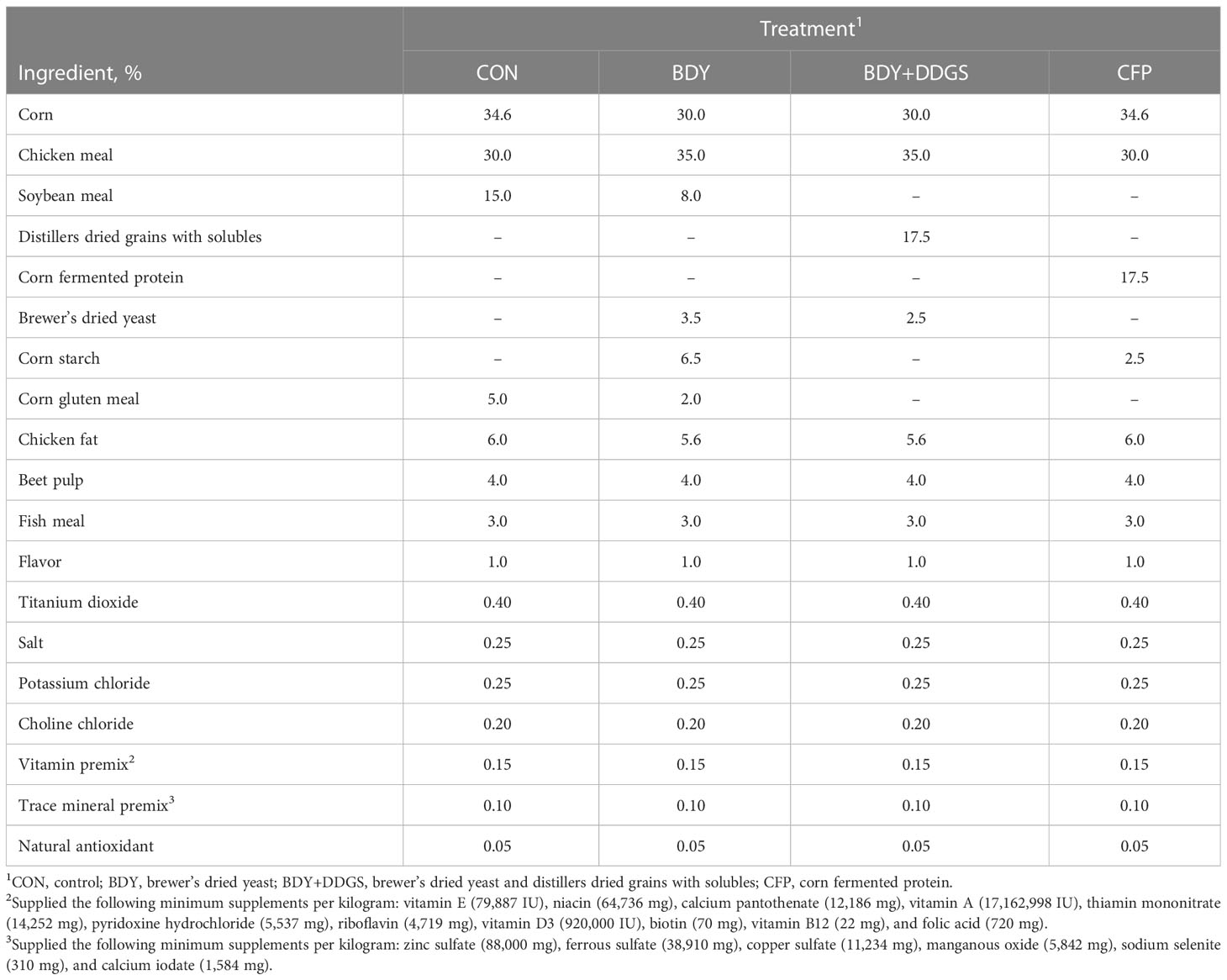
Table 1 Ingredient composition of canine diets containing yeast and ethanol co-products on an as-is basis.
Each diet was mixed and produced using a single-screw extruder (model E525, Extru-Tech, Manhattan, KS). The cool and dry products were packaged in laminated bags and transferred to the laboratory at Kansas State University to be coated. Kibble was coated with chicken fat protected with natural antioxidants (Nutrios, Springfield, MO) and a dry powdered flavor designed for dogs (AFB International, St. Charles, MO). The coated products were stored in poly-lined Kraft paper bags until feeding.
2.2 Feeding trial
For this study, 12 healthy adult (6.3 years ± 0.45 years) beagle dogs (eight castrated males and four spayed females) were enrolled in a triplicated 4 × 4 Latin square design. The dogs had an average body weight of 11.4 kg ± 1.2 kg. The daily metabolizable energy requirement was calculated for laboratory kennel dogs [130*BWkg0.75; NRC – National Research Council, 2006]. However, it was adjusted to 105*BWkg0.75 to maintain the body weight of dogs, which was measured at the beginning, middle, and end of each period. The experiment consisted of four periods, and each one was composed of 9 days of adaptation followed by 5 days of collection. In this model, each animal served as its own control, and each treatment had 12 total observations.
The dogs were individually housed in pens (1.83 m x 1.20 m) equipped with an acrylic-coated mesh floor to allow for the separate collection of urine and feces. Two rooms, with six animals each, were maintained in a temperature-controlled (23°C) modular building with a 12 h light cycle. The dogs received two feedings per day, at 0800 h and 1700 h, with water provided ad libitum. During the collection period, all feces were collected periodically throughout the day to prevent contamination and disturbance. The fecal samples were weighed and scored on a scale of 1–5 with 0.5 increments [1—liquid diarrhea to 5—dry hard pellets; Carciofi et al., 2008]. A score of 3.5–4.0 was considered ideal. All feces were scored by the same person for consistency. Feces were stored in labeled Whirl-pak bags in a freezer until further processing. In addition, the pH of a fresh sample (within 15 min of defecation) was recorded in triplicate with a calibrated glass-electrode pH probe (FC240B, Hanna Instruments, Smithfield, RI), and 2-g aliquots were transferred into three plastic microcentrifuge tubes using a spatula and stored at −80°C for short-chain fatty acid (SCFA) and branched-chain fatty acid (BCFA) analysis.
2.3 Digestibility calculations
After each collection period, feces from each dog were composited and dried at 55°C in a forced-air oven until constant weight (24–48 h). Dried samples were ground to pass through a 1 mm screen in a laboratory fixed blade impact mill (ZM 200, Retsch, Verder Scientific, Haan, Germany). Titanium dioxide (TiO2) concentration was measured in food and feces using a spectrophotometric plate reader (Gen5TM, Biotek® Instruments Inc., Winooski, VT) at 410 nm (Myers et al., 2004). Apparent total tract digestibility (ATTD) was estimated by titanium dioxide using the following equation:
Digestibility was calculated using both the total collection and titanium dioxide methods, which resulted in similar digestibility values and trends. However, the titanium dioxide method resulted in a lower standard error of the mean. Therefore, digestibility values from the titanium dioxide method were selected to be reported in this manuscript.
2.4 Nutrient analysis
Experimental ingredients, diets, and partially dried fecal samples were analyzed in duplicate for moisture (AOAC 930.15), ash (AOAC 942.05), fat by acid hydrolysis and hexane extraction (AOAC 960.39), gross energy (Parr 6200 Calorimeter, Parr Instrument Company, Moline, IL), and total dietary fiber (AOAC 991.43). Crude protein was determined by Dumas combustion (AOAC 990.03) using a nitrogen analyzer (FP928, LECO Corporation, Saint Joseph, MI).
The amino acid composition of experimental ingredients was analyzed at the University of Missouri Agricultural Experiment Station Chemical Laboratories (Columbia, MO; AOAC 982.30 and 988.15). All amino acids, except methionine, cysteine, and tryptophan, were digested with 6 N HCl for 24 h at 110°C. The amino acids were then separated by ion-exchange chromatography, and the concentration was determined with a Beckman 6300 amino acid analyzer (Beckman, Palo Alto, CA). Methionine and cysteine were first oxidized by performic acid to methionine sulfone and cysteic acid, respectively, prior to acid hydrolysis. Tryptophan was hydrolyzed in 3 M mercaptoethanesulfonic acid before analysis. Available lysine was determined (AOAC 975.44) and lysine availability (%) was calculated as the ratio of available lysine to total lysine.
2.5 Fecal chemical analysis
Fecal SCFA and BCFA concentrations were determined by gas–liquid chromatography (Erwin et al., 1961) using a capillary column (30 m × 0.25 mm internal diameter; 0.25 µm film thickness; Aligent Technologies, Santa Clara, CA). The system was equipped using helium as a carrier gas, with a constant flow rate of 40 cm/s, and utilized a 25:1 split ratio injector, with an injection size of 0.5 µL. A flame-ionization detector was configured with hydrogen as the makeup gas, with a flow rate of 40 mL/min, to clarify the peak resolution. The detector and injector temperatures were set at 250°C, and the initial oven temperature was set to 80°C, with a ramp rate of 10°C/min to 200°C. The peak area of chromatograms was analyzed using integrative software (GC solution version 2.42.00, Shimadzu, Kyoto, Japan). The concentrations of SCFAs (acetate, propionate, and butyrate) and BCFAs (isobutyrate, valerate, and isovalerate) were quantified by comparing the sample peak area with a known standard of 10 mM concentration (Volatile Free Acid Mix, Sigma-Aldrich, St. Louis, MO) and correcting for fecal dry-matter content.
2.6 Palatability trial
The experimental treatments (BDY, BDY+DDGS, and CFP) were evaluated for palatability in comparison with the control diet by examining dog panels at a commercial kennel (Summit Ridge Farms, Susquehanna, PA, USA). Each experiment was conducted as a split-plate test in which two stainless steel bowls containing 400 g of food were presented to dogs for a total of 30 min. Each comparison trial was repeated for 2 days, with the bowl position switched daily. Twenty dogs were fed daily, providing 40 observations for each paired comparison test. Preference was determined based on dogs’ first choice and total food consumption. A detailed description of the palatability method can be found in the review by Aldrich and Koppel (2015). Data from consumption were represented as the following ratio:
2.7 Statistics
The digestibility experiment was conducted as a 4 × 4 replicated Latin square design. Each of the 12 experimental units (dogs) were assigned to a treatment using the spreadsheet by Kim and Stein (2009). Data were analyzed using a GLIMMIX procedure in SAS (version 9.4, SAS Institute, Inc., Cary, NC), with treatment as a fixed effect and dog and period as random effects. Tukey’s post-hoc test was applied for the least-squares means separation, with significance considered at p< 0.05.
In the palatability experiment, the consumption ratios were determined using a t-test in a two-way ANOVA and the first-choice preferences were determined using a chi-squared test. The 20 dogs were considered the experimental units for analysis.
3 Results
3.1 Nutrient analysis
Among experimental ingredients, the protein content of distillers dried grains with solubles (DDGS) was lowest at 32% while corn gluten meal (CGM) was highest at 70% on a dry-matter basis (Table 2). Soybean meal (SBM) and corn fermented protein (CFP) both contained 53% protein, whereas brewer’s dried yeast (BDY) contained 47% protein. Fat content was highest in DDGS, at 12%, and lowest for SBM and BDY, at 3%. Fat levels in CGM and CFP were intermediate, at 7% and 6%, respectively. Total dietary fiber (TDF) was highest for DDGS, at 45%, and lowest for CGM, at 3%. All ingredients, except BDY, had a higher proportion of insoluble dietary fiber (IDF) than soluble dietary fiber (SDF).
The amino acid composition of experimental ingredients varied (Table 3). Corn gluten meal and DDGS had the lowest concentrations of taurine, at 0.12% and 0.11%, respectively, whereas BDY had the highest taurine concentration at 0.22%, and SBM and CFP had intermediate concentrations, at 0.19% and 0.16%, respectively. For cysteine, CGM and CFP had the highest concentrations, at 1.15% and 1.01%, respectively, whereas BDY and DDGS had the lowest concentrations, at 0.49% and 0.54%, respectively. Soybean meal had an intermediate cysteine concentration, at 0.80%. The concentration of methionine was highest for CGM and CFP, at 1.47% and 1.18%, respectively. Distillers dried grains with solubles had the lowest concentration of methionine, at 0.54%, whereas SBM and BDY had intermediate concentrations, at 0.73% and 0.70%, respectively. Soybean meal and BDY had the highest concentrations of lysine, at 3.40% and 3.22%, respectively. Lysine concentration was lowest for DDGS, at 0.99%, and intermediate for CGM and CFP, at 1.16% and 1.73%, respectively. The same trend was seen in available lysine. Lysine availability was greatest for SBM and BDY, at an average of 97%, lowest for CFP, at 90%, and intermediate for CGM and DDGS, at 96% and 94%, respectively.
When comparing the nutrient composition of dietary treatments, dry matter content was similar in all treatments, at an average of 95% (Table 4). The CFP treatment contained 92% organic matter, whereas the remaining treatments contained an average of 91% organic matter. Protein content was highest for the CON and BDY treatments, at 41%, whereas the BDY+DDGS and CFP treatments contained 38% protein on a dry-matter basis. Fat content was highest for the BDY+DDGS treatment, at 15%, compared with the remaining treatments, in which it was an average of 13%. The BDY+DDGS treatment contained the greatest amount of TDF, at 18%, whereas the CON and BDY treatments contained the lowest, at an average of 13%. The TDF content of the CFP treatment was intermediate at 15%. The same pattern among dietary treatments was observed in IDF levels. However, the lowest SDF content was observed in the CFP treatment. All diets had a higher proportion of IDF than SDF. The gross energy content of dietary treatments was similar, around 5,000 kcal/kg.
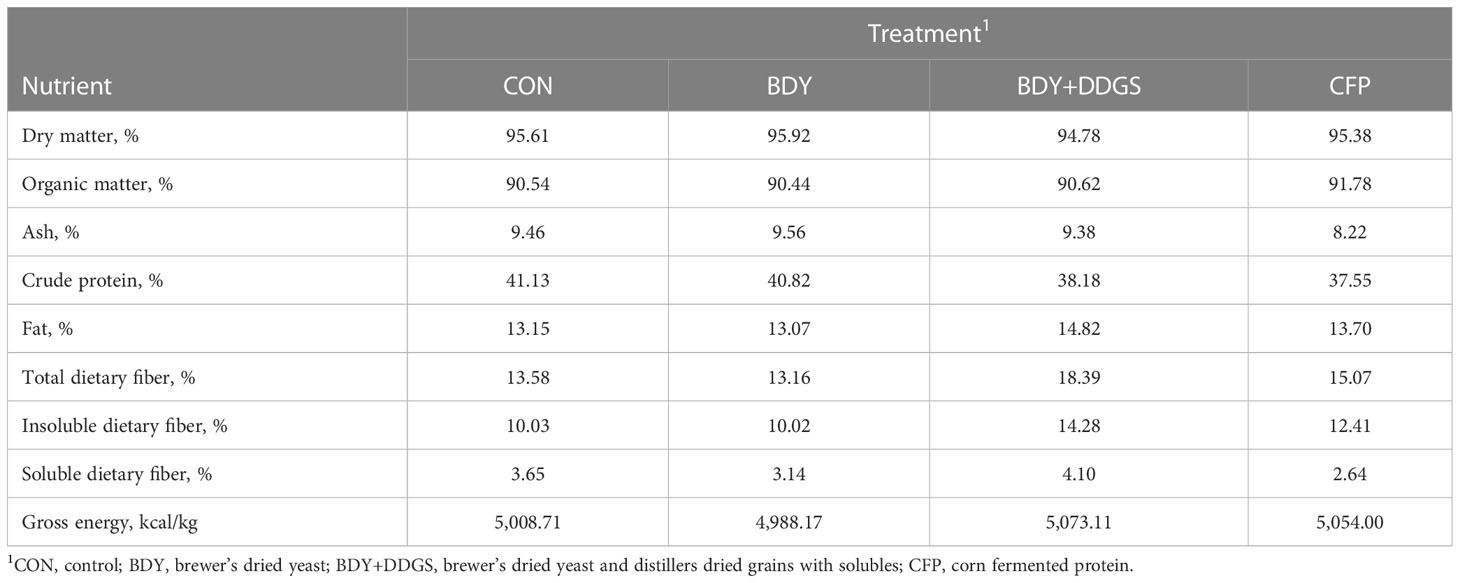
Table 4 Analyzed chemical composition of canine diets containing yeast and ethanol co-products on a dry-matter basis.
3.2 Food intake and fecal characteristics
The food intake of dogs was maintained (p> 0.05) (Table 5), whereas all stool quality parameters were significantly different among dietary treatments (Table 5). Wet fecal output was greater (p< 0.05) for dogs fed BDY+DDGS, at 125 g/d, than for dogs fed the remaining treatments at an average of 105 g/d. Feces were wetter (p< 0.05) for dogs fed CON, at 34% dry matter, than for dogs fed the remaining treatments, at 36% dry matter. Dry fecal output was highest for dogs fed the BDY+DDGS treatment, at 45 g/d, and lowest for dogs fed the CON treatment, at 35 g/d (p< 0.05). Dry fecal output of dogs fed BDY and CFP was intermediate, at 36 g/d and 39 g/d, respectively. Dogs that were fed BDY+DDGS defecated more often (p< 0.05) than dogs fed CON and BDY, with the defecation frequency for dogs fed CFP being intermediate. The feces of dogs fed CFP were firmer (p< 0.05) than those of dogs fed CON and BDY+DDGS, with the feces firmness of dogs fed BDY being intermediate.The feces of dogs fed CFP were firmer (p< 0.05) than those of dogs fed CON and BDY+DDGS, with the feces firmness of those fed BDY being intermediate. The fecal pH for dogs fed BDY was higher (p< 0.05), at 5.8, than that for dogs fed BDY+DDGS, which was 5.6, and intermediate for CON and CFP, at 5.7.
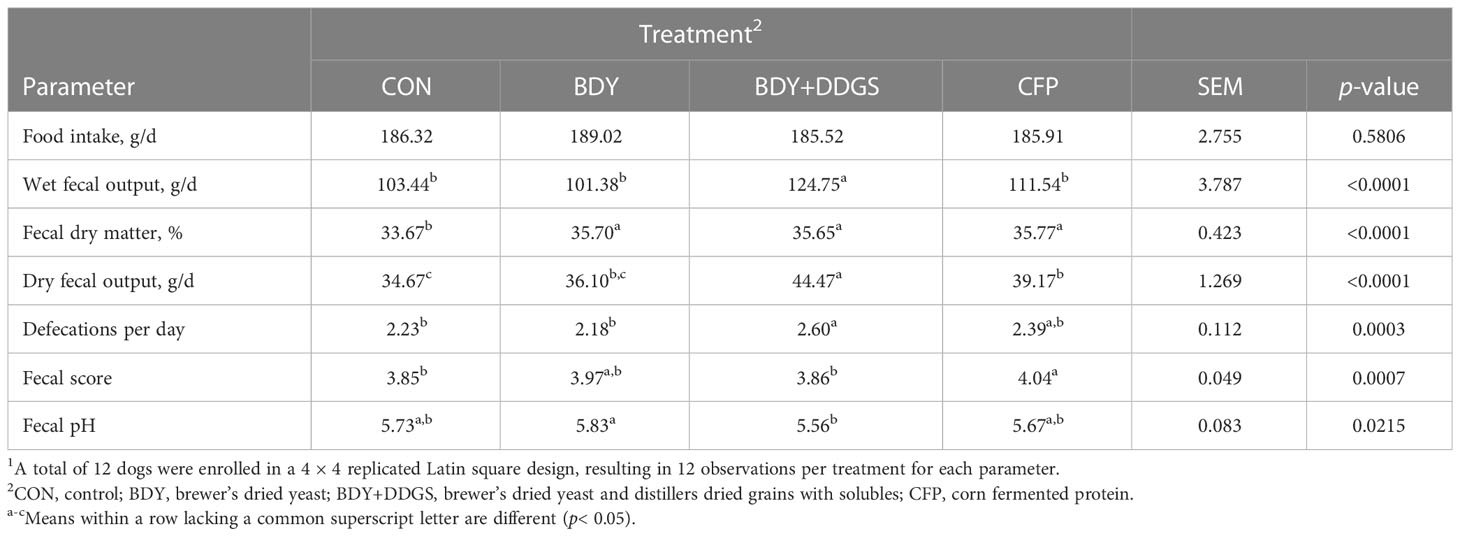
Table 5 Food-intake and stool-quality parameters of dogs fed diets containing yeast and ethanol co-products1.
3.3 Apparent total tract digestibility
Dry matter digestibility was higher (p< 0.05) for CON and BDY, at an average of 81%, than for BDY+DDGS and CFP, at an average of 77% (Table 6). Organic matter digestibility was highest (p< 0.05) for CON and BDY, at 87%, and lowest for BDY+DDGS, at 82%. The organic matter digestibility of CFP was intermediate, at 83%. Protein digestibility was highest (p< 0.05) for CON, at 88%, lowest for BDY+DDGS and CFP, at an average of 85%, and intermediate for BDY, at 87%. Fat digestibility was lower (p< 0.05) for BDY+DDGS, at 96%, than for the remaining treatments, at 98%. The digestibility of total dietary fiber was highest (p< 0.05) for CON and BDY and lowest for CFP. Gross energy digestibility was highest (p< 0.05) for CON and BDY, at 88%, lowest for BDY+DDGS, at 83%, and intermediate for CFP, at 84%.
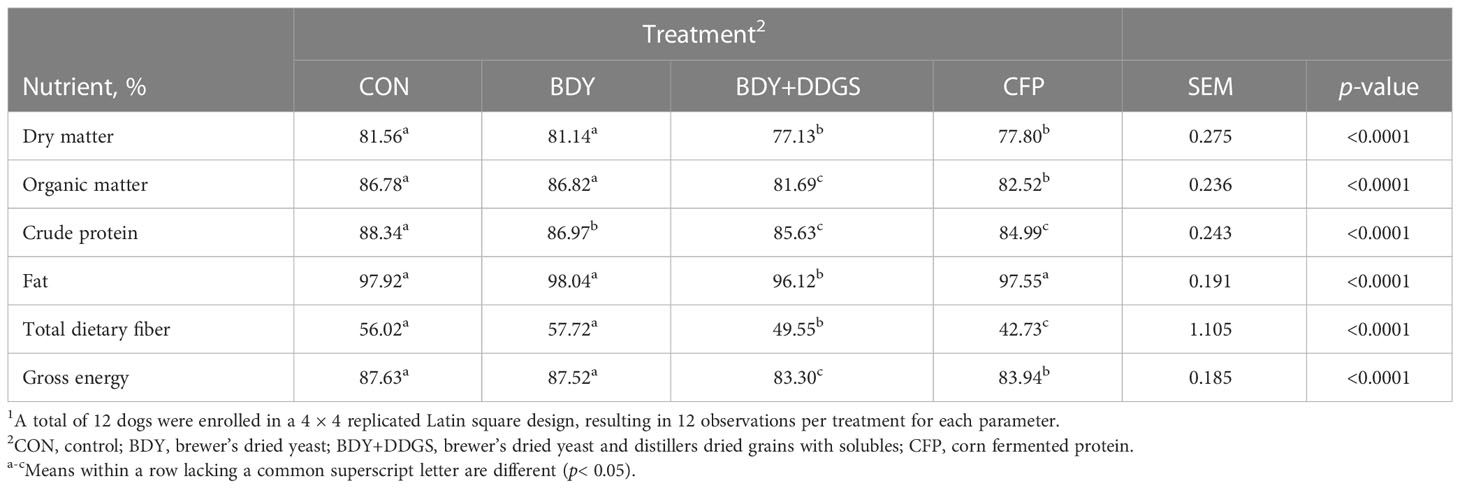
Table 6 Apparent total tract digestibility of dogs fed diets containing yeast and ethanol co-products estimated by titanium dioxide as a dietary marker on a dry-matter basis1.
3.4 Fecal chemical analysis
The total short-chain fatty acid concentration in fecal samples of dogs fed dietary treatments ranged from 351 to 421 μmol/g DM feces, but no significant differences were observed (Table 7). There were also no significant differences among dietary treatments in the percentage of acetate or butyrate, with averages of 65% and 10%, respectively. However, the percentage of propionate was higher (p< 0.05) in the fecal samples of dogs fed CON at 28% than in those of dogs fed BDY+DDGS at 24%, and BDY and CFP were intermediate at 25%. No significant differences among dietary treatments were observed in terms of the total branched-chain fatty acid concentration, which ranged from 14 to 16 μmol/g DM feces. The percentages of isovalerate and iosobutyrate in fecal samples were maintained (p> 0.05) among dietary treatments, with averages of 56% and 37%, respectively. However, the percentage of valerate was higher (p< 0.05) in the fecal samples of dogs fed CON at 9.3% than in those of dogs fed CFP at 4.4%, and intermediate in those of dogs fed BDY and BDY+DDGS, at 6.2% and 8.3%, respectively.
3.5 Palatability
When comparing CON with BDY or BDY+DDGS, dogs had no preference; this was indicated by the non-significant first choices and intake ratios (Table 8). However, dogs appeared to prefer CON over CFP, which was indicated by the significant first choices and intake ratios. Dogs chose CFP first in only 13 out of 40 observations and consumed less CFP than CON (p< 0.05).
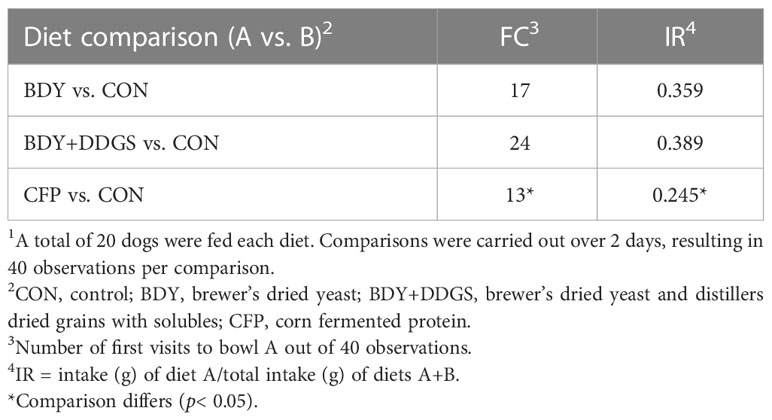
Table 8 First choice (FC) and intake ratio (IR) of dogs fed diets containing yeast and ethanol co-products1.
4 Discussion
4.1 Nutrient analysis
As new ingredients for pet food are emerging, it is important to evaluate their amino acid composition to ensure complement ingredients are utilized within a dietary matrix to meet nutrient requirements. Dogs and cats require 10 essential amino acids, namely arginine, histidine, isoleucine, leucine, lysine, methionine, phenylalanine, threonine, tryptophan, and valine. In addition, cats have an additional dietary requirement for taurine. Taurine, cysteine, methionine, and lysine are often the amino acids of most concern due to their low concentration in ingredients utilized in pet food, their roles within the body, and/or their degradation during processing.
Taurine, a sulfur-containing amino acid, is mainly found in cardiac and skeletal muscle. However, low concentrations of taurine are also commonly found in some plant ingredients (Spitze et al., 2003; Donadelli et al., 2019). This free amino acid is known to have a role in the conjugation of bile acids, maintenance of normal retinal and myocardial function, and the osmoregulation and modulation of calcium flux within cells (Huxtable, 1992; Sanderson, 2006). Retinal degeneration and cardiomyopathy have been linked to low blood or plasma taurine concentrations in strict carnivores (Hayes et al., 1975; Pion et al., 1987; Morris et al., 1990). Therefore, it is considered an essential amino acid for cats. However, previous studies have also linked low blood and plasma taurine concentrations to the development of dilated cardiomyopathy (DCM) in dogs (Kittleson et al., 1997; Fascetti et al., 2003). These studies, in addition to the 2018 FDA warning about a possible relationship between DCM in dogs and the consumption of grain-free diets, have highlighted the importance of adequate methionine, cysteine, and taurine levels in pet food.
During the processing of most commercial pet food, a thermal treatment, such as extrusion, is used to improve the safety and nutritive value of the product. However, the thermal process can negatively impact protein quality. Specifically, the Maillard reaction, which contributes to the desired flavor and color of the product, decreases the bioavailability of essential amino acids. During the Maillard reaction, a reducing sugar binds to a free reactive amino group of an amino acid. Due to the reactive Ɛ-amino group, lysine is often the amino acid involved in the Maillard reaction. Previous research has indicated that up to 62% of the lysine in pet food contains a bound Ɛ-amino group, likely due to the Maillard reaction (Williams et al., 2006; Rutherfurd et al., 2007). This complex, also referred to as the early Maillard reaction product (MRP), may be absorbed from the gastrointestinal tract, but it cannot be utilized by the animal (Hurrell and Carpenter, 1981; Moughan, 2003; Finot, 2005). As lysine is the first or second limiting essential amino acid in commercial pet food (NRC – National Research Council, 2006), this reduced utilization decreases the nutritive value of the food.
Due to the removal of starch during processing, the concentration of most amino acids in DDGS is three to four times higher than that of corn (Stein et al., 2006; Han and Liu, 2010). However, heat treatments during processing have been reported to decrease the availability of amino acids in DDGS, specifically lysine (Cromwell et al., 1993). In addition, due to differences in crop sourcing and processing methods, the amino acid composition of DDGS varies (Cromwell et al., 1993; Spiehs et al., 2002; Stein et al., 2006). However, the amino acid composition of the DDGS used in the current study is comparable to that used in previous reports (NRC – National Research Council, 1998; Spiehs et al., 2002; Fastinger and Mahan, 2006; Stein et al., 2006).
CFP contains higher levels of taurine, cysteine, methionine, and lysine than the DDGS evaluated in the current study. A previous study reported higher concentrations of lysine in yeast than in DDGS (Han and Liu, 2010). In addition, the lysine and taurine concentrations of the CFP evaluated in the current study were higher than that of a corn protein concentrate (Donadelli et al., 2019). Corn fermented protein also contained a higher taurine concentration than the CGM evaluated in this study and in that by Donadelli et al. (2019). Since all ingredients originate from corn protein, the main differentiator between the ingredients is the yeast component. Therefore, these results indicate that the substantial yeast component in CFP may contribute to its amino acid profile, specifically lysine and taurine, when compared with DDGS, CGM, or a corn protein concentrate. As a result, CFP inclusion in pet food could be beneficial in helping to meet pets’ amino acid requirements, such as that of taurine for cats.
The maintenance of dry matter content among dietary treatments was expected, as the drying temperature and time were controlled during the processing of all treatments. In addition, the ash content of CFP was lower than that of the SBM, BDY, and DDGS ingredients, resulting in the CFP treatment having increased organic matter compared with the remaining treatments. The lower ash content of CFP compared to DDGS is likely because CFP does not contain solubles due to its unique processing method, reducing its phosphorus content (Loy and Lundy, 2019). However, the ash content of CGM was the lowest among the experimental ingredients, indicating that CFP may have a greater mineral content than CGM. The mineral composition of CFP warrants further investigation. The decreased protein content in the BDY+DDGS treatment was expected, as DDGS contained the lowest amount of protein among the experimental ingredients. However, the decreased protein content of the CFP treatment was unexpected, as CFP contains more protein than BDY and a similar protein content to SBM. A possible explanation could be the high protein content of CGM, which likely increased the protein content of CON and BDY treatments even at the low inclusion levels. The increased fat content of BDY+DDGS compared with the other treatments was expected, as DDGS contained the highest amount of fat among the experimental ingredients. In addition, the fiber content of the dietary treatments was of no surprise due to the fiber content of the experimental ingredients. The greatest difference in nutrient composition among dietary treatments was the fiber content, which is likely to have the greatest impact on diet utilization by dogs.
4.2 Food intake and fecal characteristics
Comparable food intake by dogs among dietary treatments was expected, as the food offered per day was intentionally given in amounts that would maintain the body weight of dogs. In addition, all dogs consumed the entire portion offered each day.
The increase in fecal output with the BDY+DDGS treatment is likely due to the increased fiber content of the diet. These findings were similar to those of Yamka et al. (2003), who reported that an increase in dietary fiber resulted in decreased digestion and greater fecal mass due to an increased rate of passage through the digestive system and decreased absorption. Previous studies have also reported increased fecal output in dogs consuming CFP compared with those consuming SBM, due to an increase in dietary fiber (Kilburn-Kappeler and Aldrich, 2023; Smith and Aldrich, 2023). However, in the current study, the fecal output of dogs fed CFP was comparable to that of those dogs fed CON and/or BDY, whereas a higher fecal output was observed for those dogs fed the BDY+DDGS treatment. This indicates that the higher fiber level in DDGS than CFP had a greater effect on fecal mass when both treatments were fed to dogs.
The increased fecal dry matter percent of dogs fed BDY+DDGS and CFP was likely due to the decrease in nutrient digestibility as a result of the increased dietary fiber content. Allen et al. (1981) reported an increase in fecal dry matter percent for dogs fed a diet containing 15.7% DDGS relative to dogs fed a diet containing 0% DDGS. A previous study also reported increased fecal dry matter in dogs fed CFP compared with that observed for dogs consuming a control diet containing SBM (Kilburn-Kappeler and Aldrich, 2023). Therefore, the fiber levels in both DDGS and CFP appear to impact the dry matter percent of feces when fed to dogs.
The increased number of defecations per day for dogs fed BDY+DDGS compared with dogs fed CON and BDY was likely due to the increased fiber content in the BDY+DDGS treatment. In agreement with the current study, Smith and Aldrich (2023) reported no difference in fecal defecation among dogs consuming diets containing CFP or SBM, which contained 18% and 15% total dietary fiber, respectively. These results indicate that when compared with DDGS, CFP had less of an effect on the number of defecations per day when fed to dogs.
The similar fecal scores of dogs fed BDY+DDGS and CON is consistent with previous studies (Silva et al., 2016; Risolia et al., 2019). In agreement with the current study, Kilburn-Kappeler and Aldrich (2023) reported increased fecal scores for dogs fed diets containing 5%, 10%, and 15% CFP compared with those fed a SBM-containing control diet. In contrast, no difference in fecal scores were noted for dogs consuming a diet containing 25% CFP compared to a diet containing SBM (Smith and Aldrich, 2023). Even with statistical differences in fecal score among dietary treatments, all scores remained within ideal ranges.
Compared with those dogs fed the BDY treatment, dogs fed the BDY+DDGS treatment had a lower fecal pH. A previous study also reported a reduced fecal pH in dogs fed DDGS, indicating a possible prebiotic effect (Risolia et al., 2019). Silva et al. (2016) also observed a decreased fecal pH due to DDGS consumption in dogs, which was attributed to an increase in SCFA production (Kawauchi et al., 2011). In agreement with the current study, Kilburn-Kappeler and Aldrich (2023) reported no difference in fecal pH when dogs were fed increasing amounts of CFP, resulting in diets containing up to 16% total dietary fiber. Therefore, the increased fiber content in DDGS compared with CFP may have had a greater effect on fecal pH.
4.3 Apparent total tract digestibility
The decreased digestibility for BDY+DDGS and CFP compared with CON and BDY is likely due to the fiber content of dietary treatments. Previous studies evaluating DDGS have attributed a decrease in nutrient digestibility to increased dietary fiber in dogs (Allen et al., 1981; Corbin et al., 1984; Silva et al., 2016; Risolia et al., 2019). Silva et al. (2016) and Risolia et al. (2019) reported reduced nutrient digestibility in dry matter, organic matter, fat, and gross energy when dogs were fed DDGS. Allen et al. (1981) and Corbin et al. (1984) reported decreased dry matter digestibility in dogs with the dietary addition of DDGS. Silva et al. (2016) also reported decreased protein digestibility when DDGS were fed to dogs. However, some studies have reported no difference in protein digestibility with DDGS inclusion in dogs (Allen et al., 1981; Corbin et al., 1984; Risolia et al., 2019), whereas the current study observed decreased digestibility for all nutrients associated with the BDY+DDGS treatment.
Previous studies have reported a decreased digestibility in dogs fed diets containing CFP compared with those dogs fed SBM (Kilburn-Kappeler and Aldrich, 2023; Smith and Aldrich, 2023). For example, Smith and Aldrich (2023) reported that a diet containing CFP resulted in lower (p< 0.05) dry matter digestibility at 78% when compared to a diet containing SBM at 81% when fed to dogs. In addition, Kilburn-Kappeler and Aldrich (2023) reported a linear decrease (p< 0.05) in organic matter digestibility, with increased inclusion levels of CFP in exchange for SBM when fed to dogs. However, in the current study the BDY+DDGS treatment resulted in a greater decrease in digestibility compared to the CFP treatment. Therefore, the inclusion of CFP in pet food could be beneficial compared to traditional distillers dried grains due to the improved nutrient digestibility.
4.4 Fecal chemical analysis
Short and branched-chain fatty acids are microbial fermentation products which are influenced by undigested material in the large intestine. For example, carbohydrate fermentation yields SCFAs including acetate, propionate, and butyrate, which can reduce the pH of the lumen (Wong et al., 2006). In contrast, protein fermentation leads to the production of BCFA and ammonia (Herrin, 1940; Nery et al., 2012). Ammonia accumulation in the intestine has been shown to shorten the life of colonocytes (Lin and Visek, 1991) and has cytotoxic properties (Fung et al., 2013). Thus, an increase in SCFA and a decrease in pH, BCFA, and ammonia could be interpreted as having a positive effect on intestinal health (Verbeke et al., 2015).
Due to the increased dietary fiber content in BDY+DDGS and CFP it would be expected that SCFA production would have increased. However, total SCFA concentrations were comparable among all dietary treatments. More surprisingly, the proportion of propionate decreased in BDY+DDGS compared with CON. In contrast to the current study, Risolia et al. (2019) reported that DDGS led to increased total SCFA production and proportions of acetate and propionate when fed to dogs. The decreased valerate in CFP appeared to be due to the yeast component, as a numerical decrease was also observed in BDY and BDY+DDGS compared with CON. Even with the shifts in propionate and valerate, total SCFA and BCFA levels were unaltered, indicating that overall fermentation was not impacted by dietary treatment.
4.5 Palatability
Previous studies have evaluated the palatability of DDGS in dogs. Corbin et al. (1984) and Silva et al. (2016) reported improved palatability when dogs were fed a diet containing DDGS, whereas Risolia et al. (2019) reported palatability results similar to the current study, finding no preference based on first choice or intake ratio in dogs when comparing a control diet with a diet containing DDGS.
Previous studies have also compared the palatability of CFP with SBM in dogs, with varying results. Smith and Aldrich (2023) reported no preference between a diet containing 25% CFP to a diet containing SBM or CFP when fed to dogs. Kilburn-Kappeler and Aldrich (2023) reported no preference when a 5% inclusion of CFP was compared with a control diet containing SBM. However, increased CFP inclusion levels at 10% and 15% appeared to decrease palatability when fed to dogs (Kilburn-Kappeler and Aldrich, 2023). In the current study, a 17.5% inclusion of CFP appeared to decrease palatability when compared with a control diet containing SBM. When including CFP in pet food, additional palatant could easily be added to prevent the possibility of decreased palatability. However, the palatability results are interesting, as the highest CFP inclusion level (25%) did not appear to affect palatability, whereas palatability decreased with lower inclusion levels. This may indicate that the entire diet matrix or individual dogs impact palatability results. Regardless, dogs willingly consumed all treatments, and no refusals were observed.
5 Conclusion
Overall, the inclusion of CFP compared with DDGS resulted in improved stool quality and nutrient digestibility when fed to dogs. Compared with DDGS, the inclusion of CFP in pet food could be beneficial due to its enhanced nutrient composition, which is likely due to its substantial yeast component. The improved amino acid profile and decreased fiber content of CFP compared with DDGS allows CFP to be better equipped to meet nutrient requirements and results in higher nutrient digestibility. However, the inclusion of CFP may be limited regarding palatability. In conclusion, CFP may be utilized as a protein source for pet food which could increase the consumer appeal of co-products from the ethanol industry, resulting in more sustainable products.
This study provided valuable insight regarding the comparison of traditional distillers dried grains to CFP, a novel ingredient containing both yeast and distillers dried grains, when fed to dogs. However, it would be beneficial to conduct a future study utilizing CGM as the control ingredient instead of SBM, allowing for an evaluation of corn protein. In addition, the experimental ingredients should be exchanged equally, without the addition of SBM, CGM, or corn starch. Finally, the major contributor impacting the results was likely the varying fiber content of the dietary treatments. Therefore, the future study should also maintain fiber content among dietary treatments to exclusively evaluate the effect of experimental ingredients.
Data availability statement
The original contributions presented in the study are included in the article/supplementary material. Further inquiries can be directed to the corresponding author.
Ethics statement
The animal study was reviewed and approved by Kansas State University Institutional Animal Care and Use Committee (IACUC).
Author contributions
CA and LK-K formulated the diets and designed the study. KLA collected samples. LK-K and KLA carried out sample analysis. LK-K conducted the statistical analysis and primary writing. CA and CP provided editing and interpretation. All authors contributed to the article and approved the submitted version.
Acknowledgments
We gratefully acknowledge the financial support provided by POET Bioproducts, Sioux Falls, SD.
Conflict of interest
The authors declare that the research was conducted in the absence of any commercial or financial relationships that could be construed as a potential conflict of interest.
Publisher’s note
All claims expressed in this article are solely those of the authors and do not necessarily represent those of their affiliated organizations, or those of the publisher, the editors and the reviewers. Any product that may be evaluated in this article, or claim that may be made by its manufacturer, is not guaranteed or endorsed by the publisher.
References
Aldrich G. C., Koppel K. (2015). Pet food palatability evaluation: a review of standard assay techniques and interpretation of results with a primary focus on limitations. Animals. 5, 43–55. doi: 10.3390/ani5010043
Allen S. E., Fahey G. C. Jr., Corbin J. E., Pugh J. L., Franklin R. A. (1981). Evaluation of byproduct feedstuffs as dietary ingredients for dogs. J. Ani. Sci. 53, 1538–1544. doi: 10.2527/jas1982.5361538x
Carciofi A. C., Takakura F. S., de-Oliveira L. D., Teshima E., Jeremias J. T., Brunetto M. A., et al. (2008). Effects of six carbohydrate sources on cat diet digestibility and post-prandial glucose and insulin response. J. Ani. Phys. Ani. Nutr. 92, 326–336. doi: 10.1111/j.1439-0396.2007.00794.x
Corbin J., Fahey G. C., Pugh J. L. (1984). “Distillers dried grains with solubles for growing puppies,” in Distillers Feed Conference. 29–34.
Cromwell G. L., Herkelman K. L., Stahly T. S. (1993). Physical, chemical, and nutritional characteristics of distillers dried grain with solubles fed to chicks and pigs. J. Anim. Sci. 71, 679–686. doi: 10.2527/1993.713679x
Donadelli R. A., Aldrich C. G., Jones C. K., Beyer R. S. (2019). The amino acid composition and protein quality of various egg, poultry meal by-products, and vegetable proteins used in the production of dog and cat diets. Poult Sci. 98, 1371–1378. doi: 10.3382/ps/pey462
EERE – Office of Energy Efficiency and Renewable Energy U.S. Department of energy. Alternative fuels data center. Ethanol fuel basics. Available at: https://afdc.energy.gov/fuels/ethanol_fuel_basics.html (Accessed March 2023).
Erwin E. S., Marco G. J., Emery E. M. (1961). Volatile fatty acid analyses of blood and rumen fluid by gas chromatography. J. Dairy Sci. 44, 1768–1771. doi: 10.3168/jds.S0022-0302(61)89956-6
Fascetti A. J., Reed J. R., Rogers Q. R., Backus R. C. (2003). Taurine deficiency in dogs with dilated cardiomyopathy: 12 cases, (19997–2001). J. Amer. Vet. Med. Assoc. 223, 1137–1141. doi: 10.2460/javma.2003.223.1137
Fastinger N. D., Mahan D. C. (2006). Determination of the ileal amino acid and energy digestibilities of corn distillers dried grains with solubles using grower-finisher pigs. J. Anim. Sci. 84, 1722–1728. doi: 10.2527/jas.2005-308
Finot P. A. (2005). The absorption and metabolism of modified amino acids in processed foods. J. AOAC Int. 88, 894–903. doi: 10.1093/jaoac/88.3.894
Fung K. Y., Ooi C. C., Zucker M. H., Lockett T., Williams D. B., Cosgrove L. J., et al. (2013). Colorectal carcinogenesis: a cellular response to sustained risk environment. Int. J. Mol. Sci. 14, 13525–13541. doi: 10.3390/ijms140713525
Han J., Liu K. (2010). Changes in composition and amino acid profile during dry grind ethanol processing from corn and estimation of yeast contribution toward DDGS proteins. J. Agric. Food Chem. 58, 3430–3437. doi: 10.1021/jf9034833
Hayes K. C., Carey R. E., Schmidt S. Y. (1975). Retinal degeneration associated with taurine deficiency in the cat. Sci. 188, 949–951. doi: 10.1126/science.1138364
Herrin R. C. (1940). The secretion of ammonia by the small intestine of the dog. Am. J. Physiol. Content. 129, 146–154. doi: 10.1152/ajplegacy.1940.129.1.146
Hurrell R. F., Carpenter K. J. (1981). The estimation of available lysine in foodstuffs after Maillard reactions. Prog. Food Nutr. Sci. 5, 159–176.
Huxtable R. J. (1992). Physiological actions of taurine. Physiol. Rev. 72, 101–163. doi: 10.1152/physrev.1992.72.1.101
Kawauchi I. M., Sakomura N. K., Vasconcellos R. S., De-Oliveira L. D., Gomes M. O. S., Loureiro B. A., et al. (2011). Digestibility and metabolizable energy of maize gluten feed for dogs as measured by two different techniques. Anim. Feed Sci. Techn. 169, 96–103. doi: 10.1016/j.anifeedsci.2011.05.005
Kilburn-Kappeler L. R., Aldrich C. G. (2023). Evaluation of graded levels of corn fermented protein (CFP) on extrusion processing and diet utilization in healthy adult dogs. Front. Anim. Sci. Submitted. 4, 1202270. doi: 10.3389/fanim.2023.1202270
Kilburn-Kappeler L. R., Lema Almeida K. A., Aldrich C. G. (2022). Evaluation of graded levels of corn-fermented protein on stool quality, apparent nutrient digestibility, and palatability in healthy adult cats. J. Anim. Sci. 100, 1–6. doi: 10.1093/jas/skac354
Kim B. G., Stein H. H. (2009). A spreadsheet program for making a balanced latin square design. Rev. Colomb. Cienc. Pecu. 22, 591–596.
Kittleson M. D., Keene B., Pion P. D., Loyer C. G. (1997). Results of the multicenter spaniel trial (MUST): taurine-and carnitine-responsive dilated cardiomyopathy in American cocker spaniels with decreased plasma taurine concentration. J. Vet. Inter. Med. 11, 204–211. doi: 10.1111/j.1939-1676.1997.tb00092.x
Lin H. C., Visek W. J. (1991). Colon mucosal cell damage by ammonia in rats. J. Nutr. 121, 887–893. doi: 10.1093/jn/121.6.887
Loy D. D., Lundy E. L. (2019). “Nutritional properties and feeding value of corn and its coproducts,” in Corn: chemistry and technology, 3rd ed (Elsevier Inc. in cooperation with AACC International). doi: 10.1016/B978-0-12-811971-6.00023-1
Morris J. G., Rogers Q. R., Pacioretty L. M. (1990). Taurine: an essential nutrient for cats. J. Sm. Anim. Pract. 31, 502–509. doi: 10.1111/j.1748-5827.1990.tb00672.x
Moughan P. J. (2003). Amino acid availability: aspects of chemical analysis and bioassay methodology. Nutr. Res. Rev. 16, 127–141. doi: 10.1079/NRR200365
Myers W. D., Ludden P. A., Nayigihugu V., Hess B. W. (2004). Technical Note: A procedure for the preparation and quantitative analysis of samples for titanium dioxide. J. Anim. Sci. 82, 179–183. doi: 10.2527/2004.821179x
Nery J., Goudez R., Biourge V., Tournier C., Leray V., Martin L., et al. (2012). Influence of dietary protein content and source on colonic fermentative activity in dogs differing in body size and digestive tolerance. J. Anim. Sci. 90, 2570–2580. doi: 10.2527/jas.2011-4112
NRC – National Research Council. (1998). Nutrient requirements of swine. 10th rev (Washington, DC: National Academies Press).
NRC – National Research Council. (2006). Nutrient requirements of dogs and cats (Washington, DC: National Academies Press).
Pion P. D., Kittleson M. D., Rogers Q. R., Morris J. G. (1987). Myocardial failure in cats associated with low plasma taurine: a reversible cardiomyopathy. Sci. 237, 764–768. doi: 10.1126/science.3616607
Renewable Fuels Association. (2023). Ethanol industry outlook 2023. Available at: https://d35t1syewk4d42.cloudfront.net/file/2432/2023%20RFA%20Outlook%20FINAL.pdf (Accessed March 2023).
Risolia L. W., Sabchuk T. T., Murakami F. Y., Félix A. P., Maiorka A., Oliveira S. G. (2019). Effects of adding dried distillers grains with solubles (DDGS) to dog diets supplemented with xylanase and protease. Rev. Bras. Zootecnia. 48, e20190112. doi: 10.1590/rbz4820190112
Rutherfurd S. M., Rutherfurd-Markwick K. J., Moughan P. J. (2007). Available (ileal digestible reactive) lysine in selected pet foods. J. Agric. Food Chem. 55, 3517–3522. doi: 10.1021/jf062919t
Sanderson S. L. (2006). Taurine and carnitine in canine cardiomyopathy. Vet. Clin. North Am. Small Anim. Pract. 36, 1325–1343. doi: 10.1016/j.cvsm.2006.08.010
Silva J. R., Sabchuk T. T., Lima D. C., Félix A. P., Maiorka A., Oliveira S. G. (2016). Use of distillers dried grains with solubles (DDGS), with and without xylanase, in dog food. Anim. Feed Sci. Techn. 220, 136–142. doi: 10.1016/j.anifeedsci.2016.08.001
Smith S. C., Aldrich C. G. (2023). Evaluation of corn fermented protein as a dietary ingredient in extruded dog and cat diets. Trans. Anim. Sci. 7, txad032. doi: 10.1093/tas/txad032
Spiehs M. J., Whithey M. H., Shurson G. C. (2002). Nutrient database for distiller’s dried grain with solubles produced from new plants in Minnesota and South Dakota. J. Anim. Sci. 80, 2639–2645. doi: 10.2527/2002.80102639x
Spitze A. R., Wong D. L., Rogers Q. R., Fascetti A. J. (2003). Taurine concentrations in animal feed ingredients; cooking influences taurine content. J. Anim. Physiol. Anim. Nutr. 87, 251–262. doi: 10.1046/j.1439-0396.2003.00434.x
Stein H. H., Pedersen C., Gibson M. L., Boersma M. G. (2006). Amino acid and energy digestibility in ten samples of dried distillers grain with solubles by growing pigs. J. Anim. Sci. 84, 853–860. doi: 10.2527/2006.844853x
Verbeke K. A., Boobis A. R., Chiodini A., Edwards C. A., Franck A., Kleerebezem M., et al. (2015). Towards microbial fermentation metabolites as markers for health benefits of prebiotics. Nutr. Res. Rev. 28, 42–66. doi: 10.1017/S0954422415000037
Williams P. A., Hodgkinson S. M., Rutherfurd S. M., Hendriks W. H. (2006). Lysine content in canine diets can be severely heat damaged. J. Nutr. 136, 1998S–2000S. doi: 10.1093/jn/136.7.1998S
Wong J. M., de Souza R., Kendall C. W., Emam A., Jenkins D. J. (2006). Colonic health: fermentation and short chain fatty acids. J. Clin. Gastroenterol. 40, 235–243. doi: 10.1097/00004836-200603000-00015
Yamka R. M., Jamikorn U., True A. D., Harmon D. L. (2003). Evaluation of soyabean meal as a protein source in canine foods. J. Anim. Feed Sci. Tech. 109, 121–132. doi: 10.1016/S0377-8401(03)002303-7
Keywords: canine, corn fermented protein, distillers dried grains with solubles, nutrient digestibility, palatability, stool quality
Citation: Kilburn-Kappeler LR, Lema Almeida KA, Paulk CB and Aldrich CG (2023) Comparing the effects of corn fermented protein with traditional distillers dried grains fed to healthy adult dogs on stool quality, nutrient digestibility, and palatability. Front. Anim. Sci. 4:1210144. doi: 10.3389/fanim.2023.1210144
Received: 21 April 2023; Accepted: 21 July 2023;
Published: 08 August 2023.
Edited by:
Otávio R. Machado Neto, São Paulo State University, BrazilReviewed by:
Mayra A. D. Saleh, University of the Azores, PortugalSakine Yalçin, Ankara University, Türkiye
Copyright © 2023 Kilburn-Kappeler, Lema Almeida, Paulk and Aldrich. This is an open-access article distributed under the terms of the Creative Commons Attribution License (CC BY). The use, distribution or reproduction in other forums is permitted, provided the original author(s) and the copyright owner(s) are credited and that the original publication in this journal is cited, in accordance with accepted academic practice. No use, distribution or reproduction is permitted which does not comply with these terms.
*Correspondence: Charles G. Aldrich, YWxkcmljaDRAa3N1LmVkdQ==
 Logan R. Kilburn-Kappeler
Logan R. Kilburn-Kappeler Krystina A. Lema Almeida
Krystina A. Lema Almeida Charles G. Aldrich
Charles G. Aldrich